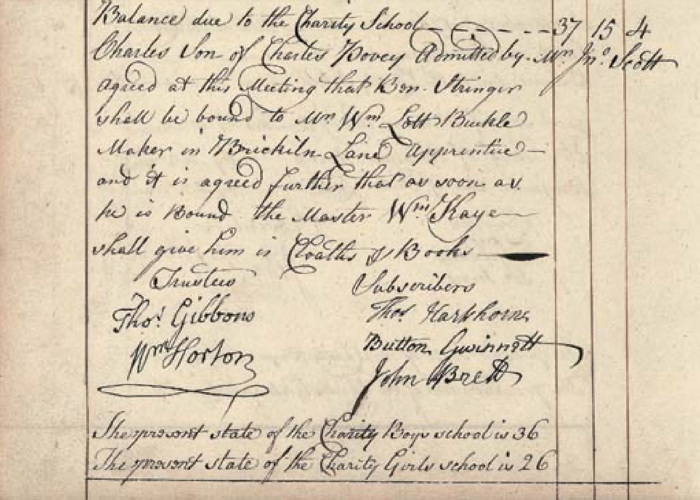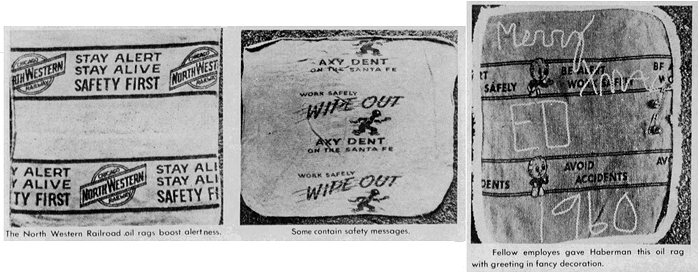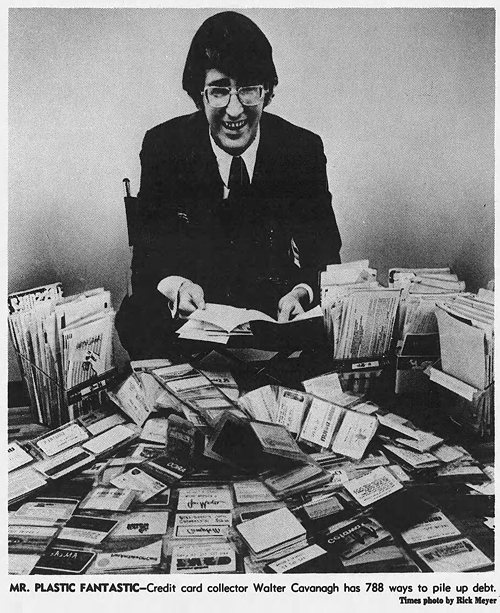Collectors
The art collection of the British Rail Pension Fund
Fine art and British Rail may not seem like they have much in common, but for several decades British Rail, through its pension fund, was a major player in the world of fine art. From theNY Times (Apr 5, 1989):
The pension fund began selling its art in 1986, and sold the last of it in 2003.
The Wall Street Journal reported in 1996 that the pension fund made a return of 13.1% per year on its art. Which doesn't seem bad at all. However, its stock portfolio, during the same period, returned 22% a year.
If you're looking for a coffee-table curiosity, there are several books dedicated to the artwork owned by the British Rail pension fund.
More info: "When a railway fund started buying paintings"


Posted By: Alex - Fri Sep 20, 2024 -
Comments (0)
Category: Art, Money, Collectors
A collection of objects no larger than a man’s hand
At "Sleepless Hollow," his country home in Lake Hopatcong, New Jersey, comedian Joe Cook kept a collection of objects "no larger than a man's hand." This included, "safety pins, collar buttons, unset stones, Japanese netsukes, miniature bibles, bathtub faucets, tin soldiers, perfume bottles, and ball bearings."The objects hung from the ceiling of his trophy room.


Tower Radio magazine - Sep 1934
Sleepless Hollow was full of other oddities, such as a "golf tree" on which golf balls grew (they had been wired on). More from Wikipedia:
Cook was diagnosed with Parkinson's disease in 1941. This forced his retirement from show business. He sold the lake house the same year and moved to a more modest residence in New York State, where he resided until his death in 1959.

Sleepless Hollow's funnel-shaped golf green
Posted By: Alex - Tue Dec 26, 2023 -
Comments (2)
Category: Collectors
The Signature of Button Gwinnett
In the world of signature collecting the "holy grail" is to obtain a signature of Button Gwinnett, a representative from Georgia to the Continental Congress and also a signer of the Declaration of Independence. As explained by Wikipedia:In 2022, a copy sold for $1.4m.
If you're going to build a device to move objects through time, I think you can do better than that.

image source: Christies.com
Posted By: Alex - Mon Dec 18, 2023 -
Comments (0)
Category: Collectors, Eighteenth Century
Reamer Collectors
If you collect reamers, consider joining the NRCA (National Reamer Collectors Association).
The NRCA used to have its own website, reamers.org, but no longer. (The old site was archived by the Wayback Machine.) Now they have a private facebook page instead.

Some explanatory text about reamers from their old website:
The reamers were invented over 200 years ago out of necessity when it was discovered that citrus provided a cure for diseases like scurvy. The first reamers were all producted in Europe. Major china companies such as Bayreuth, Miessen, Royal Rudolstadt and Limoges produced reamers for some of the finer tables in Europe.
The first reamer was patented in the United States around 1867, after the Civil War. It was a hand held reamer. Next came the one piece reamer with a small saucer and a cone that was meant to fit on top of a glass. These were quite messy as they slid and slipped off of the glass. In the 1880's a glass rim was added to the bottom of the saucer to help keep the reamer on the glass. Around the same time, wooden squeezers with a press action were also being used. Two-piece sets with measuring pitcher bottoms and separate reamer tops did not come along until the mid 1920's.
The biggest boom for reamers came in 1907 when a a co-op named the "California Fruit Growers Exchange" was formed. This co-op marketed the name Sunkist to sell fruit to the east coast. Sunkist reamers were produced as a promotional item. However, not until 1916 when the "Drink an Orange" campaign was launched, were reamers marketed to the masses.
I have an old glass reamer — a family hand-me-down. I didn't know it was called a reamer, nor that it was something people might collect.
Posted By: Alex - Fri Mar 03, 2023 -
Comments (3)
Category: Collectors
World’s Largest Collection of 8-Track Tapes
Posted By: Paul - Thu Jun 09, 2022 -
Comments (0)
Category: Eccentrics, Collectors, Kitsch and Collectibles, Music, Technology
Ed Haberman, collector of oil rags
Ed Haberman of Tama, Iowa collected oil rags. The kind used in garages to clean oil dip sticks. He started collecting them in 1956, and by the time he died in 1988 he had over 1300 of them.
Quad City Times - Feb 4, 1973
In 1968, he talked about his collection to a reporter from the Des Moines Register (Nov 10, 1968):
"I kept exchangin' dirty oil rags for clean ones at Wilkinson's," he says. "Pretty soon, I decided I needed more than one rag. I guess it was when I had about nine oil rags that it suddenly occurred to me to collect them. Pretty soon, I was watchin' for discarded oil rags all the time — you can find them almost anywhere. When I'd find one, I'd take it back to Tama and exchange it for a clean, new one."
There is little rhyme or reason to Haberman's method. For example, he quickly discarded the idea of keeping dirty oil rags because his wife, Eleanor, 52, would have none of it.
"I don't even care much for his CLEAN oil rags," she said last week. "In fact, I think the whole idea is pretty stupid. It gets pretty nerve-racking when we're out on a trip and he keeps stopping the car every time he sees a dirty old oil rags. But I guess as long as he keeps them in a neat pile and out of my way, it's all right."...
"People come to my basement," Haberman says, "Look at my pile of rags and just stand there laughing. I know they're probably laughing at me, but I don't care. Really, I don't. They don't understand. I just laugh along with them. But, all the time, I know I've done something no one else has.
"It's important for a man to accomplish something. For me, it's collecting oil rags. I happen to enjoy doing it."

Quad City Times - Feb 4, 1973
Posted By: Alex - Sun May 29, 2022 -
Comments (3)
Category: Collectors
Charles Davis, collector of elephant hairs
Charles Davis collected elephant hairs — in particular the long hairs that grow from their tails. By the time he was 83, in 1962, he had hairs from 357 different elephants.
Cincinnati Enquirer - June 14, 1959
Details from a syndicated article by Ramon J. Geremia (Weirton Daily Times - Mar 24, 1962)
But the elephant hairs make up the bulk of the collection of elephantiana. The longest one is 13 inches, the shortest, plucked from a 200 pound baby elephant, is one and one-half inches long. They include colors ranging from black to white with a few red chin whiskers.
Most of them were plucked from elephant tails — some were cut from the more belligerent behemoths. Every zoo in the nation is represented, except the Bronx Zoo in New York...
Davis started his unusual hobby as an elephantphile in 1928. He asked a circus elephant trainer to suggest something he could collect from or about elephants and the trainer suggested hair. Davis, a retired optometrist, says his collection "took my mind off business."
Posted By: Alex - Fri May 20, 2022 -
Comments (0)
Category: Animals, Collectors, Hair and Hairstyling
Mr. Plastic Fantastic
Walter Cavanagh's hobby is collecting active credit cards issued in his name. Which is to say that he's not interested in collecting the cards themselves, as a typical credit card collector might be (such as a member of the American Credit Card Collectors Society). Cavanagh's collection consists entirely of cards that he could use to buy something.By the mid-1970s, when the media first got wind of him (and dubbed him 'Mr. Plastic Fantastic'), he had already acquired 788 cards, giving him available credit of $750,000.
By 2016, in the most recent update about him that I could find, his collection was up to 1,497 cards, giving him available credit of $1.7 million.
However, he never taps into this credit. He uses only one card, and he always pays off the balance in full each month.

Los Angeles Times - Feb 1, 1976
But how does he keep getting companies to send him new cards? Wouldn't companies see the huge amount of credit already available to him and deny his application? Apparently not. Cavanagh reports that he's hardly ever had an application denied.
According to the Next Gen Personal Finance blog, this shouldn't be surprising. Both his payment and credit history are long and positive. Also:
So companies keep sending him new cards.

Posted By: Alex - Tue May 10, 2022 -
Comments (8)
Category: Money, World Records, Collectors
The Dorothy who collected Dorothys
Dorothy Richert collected stories about people named Dorothy. Which meant that, once the news story about her had appeared in the paper, she could collect herself.She held an unusual belief about her name:
Hmm. That would never have occurred to me. In fact, I could think of only two famous people named Dorothy: Dorothy Parker and Dorothy Sayers. Apparently Faye Dunaway's first name is Dorothy, but I don't think she should count because she's famous as Faye, not Dorothy. There's various lists around the web (here and here) if you want to learn about some other famous Dorothys.
As an Alex, the most famous Alex ever is pretty obvious and, I assume, will never be topped.


Port Huron Times Herald - Mar 12, 1950
Posted By: Alex - Sun Dec 26, 2021 -
Comments (4)
Category: Collectors, 1950s
Banana Label Collecting
Banana-label collecting is not only a thing. It has an active community of collectors.One of the top collectors is Becky Martz who now has over 22,630 labels. She's archived them at her website, Becky's Gone Bananas.

You can also check out the BananaLabel Catalog of the Produce Real Society. There's not many labels to see on their website, but they sell a master catalog of 31,000 labels going all the way back to 1913.

Posted By: Alex - Thu Sep 16, 2021 -
Comments (5)
Category: Collectors, Bananas

| Who We Are |
|---|
| Alex Boese Alex is the creator and curator of the Museum of Hoaxes. He's also the author of various weird, non-fiction, science-themed books such as Elephants on Acid and Psychedelic Apes. Paul Di Filippo Paul has been paid to put weird ideas into fictional form for over thirty years, in his career as a noted science fiction writer. He has recently begun blogging on many curious topics with three fellow writers at The Inferior 4+1. Contact Us |




